The regular NFPA inspection of commercial fire sprinkler heads
The National Fire Protection Association (NFPA) has outlined the items needed to keep commercial fire sprinklers working and up to code in NFPA 25: Standard for the Inspection, Testing, and Maintenance of Water-Based Fire Protection Systems. This series outlines the major steps that should be taken to inspect a commercial fire sprinkler system, why they are required, and how to deal with any issues that are spotted. We’ll start with the annual inspection of fire sprinkler heads and other key parts.
Are you looking to buy parts for your commercial fire sprinkler system? If so, feel free to skip directly to our selection of commercial fire sprinkler heads, cover plates, escutcheons, and other components and tools, or just use the search bar at the top of the page to find what you’re looking for.
The annual visual inspection of fire sprinkler heads, pipe, and fittings
NFPA 25 requires someone to conduct an annual visual inspection – “from the floor level” – of both sprinkler heads and the pipe and fittings they are attached to:
From the 2017 Edition of NFPA 25
5.2.1.1 Sprinklers shall be inspected from the floor level annually.
5.2.2* Pipe and Fittings. Sprinkler pipe and fittings shall be inspected annually from the floor level.
Since each of these components must be inspected at the same interval and they can be viewed together, you can knock out both requirements during the same inspection. This piece will cover the annual inspection of sprinklers, whereas our next blog in the series dives deep into the inspection of pipe and fittings.
Issues to look for during the annual inspection of fire sprinkler heads – and what to do about any you find
There are five things you are looking to spot: Damage, incorrect orientation of a sprinkler head, missing sprinklers or components, proper clearance between sprinkler heads and any objects, and that your stock of replacement components and tools is adequate.
Damage
From the 2017 Edition of NFPA 25
5.2.1.1.1* Any sprinkler that shows signs of any of the following shall be replaced:
(1) Leakage
(2) Corrosion detrimental to sprinkler performance
(3) Physical damage
(4) Loss of fluid in the glass bulb heat-responsive element
(5) Loading detrimental to sprinkler performance
(6) Paint other than that applied by the sprinkler manufacturer
Obviously, leakage that can be spotted by a visual inspection will involve looking for signs of water when it involves a wet system. Any noticeable physical damage also obviously requires correction. Corrosion that could be detrimental to sprinkler performance includes build-up and/or degradation that interferes with the operation of a sprinkler head.
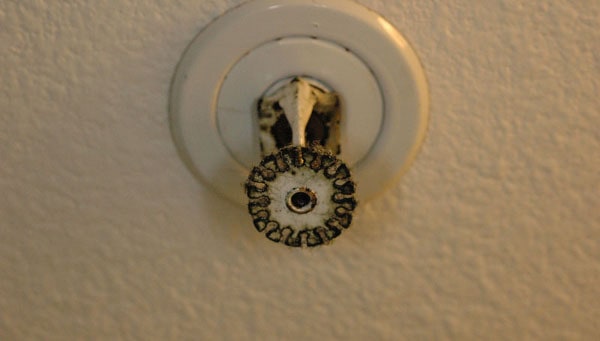
Also, closely look at the translucent, heat-responsive elements (in sprinklers that have them) to see if the fluid is missing or low. The liquid is most often red in color, but it could be orange, yellow, green, blue, or purple, depending on the sprinkler’s temperature rating. Without this fluid, the glass will not break when exposed to high temperature, which means the sprinkler will not deploy during a fire.
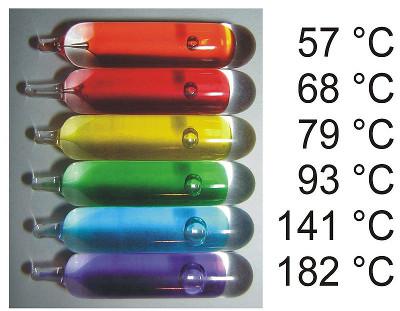
“Loading” refers to accumulated dust or other sediment on a fire sprinkler; if this gets too heavy, the accumulation can shield the heat-sensitive element from high temperatures or gum up the deflector.
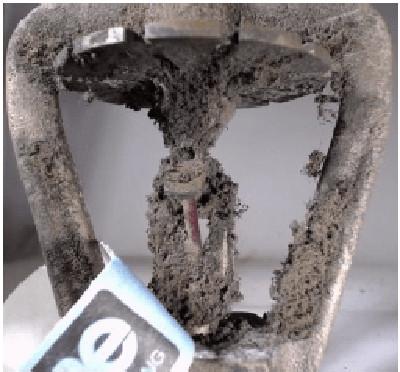
Grant Lobdell, a lab manager at Dyne Technologies, LLC, took a look at the issues surrounding sprinkler-head loading in Sprinkler Age, summarizing a study that “measured the response times of various sprinklers with different amounts of loading to help give an idea of how sprinkler thermal sensitivity is affected and when performance is no longer acceptable.”
Lobdell concluded that “Any amount of loading can have some impact on the thermal sensitivity of a sprinkler. Even light loading can push the sprinkler’s RTI [Response Time Index – how long it takes sprinklers to deploy] value near the allowed maximum.”
Essentially, determining how much loading affects the response times of sprinklers is hard to estimate visually, and the decision to replace or simply clean sprinklers is a “subjective call.” Thus, the author’s recommendation is to treat any significant loading as “detrimental” to the performance of the sprinkler head – which would require a replacement.
If there is a light covering of dust, the head can simply be cleaned; see our guide to cleaning a sprinkler head.
In the case of spotting a painted sprinkler, default to replacing the sprinkler head. Painted-over cover plates on concealed sprinklers can block sprinkler deployment, and a painted heat element in any head will shield the heat-sensitive liquid from detecting the temperature – also delaying or stopping deployment. Paint can also gum up the deflector, preventing it from fanning water throughout the intended coverage area.
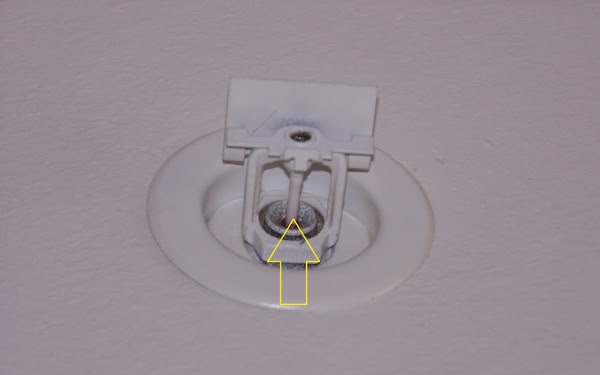
Incorrect orientation
Sprinkler heads must be positioned correctly to deliver water over the area that is specified by the system’s design.
From the 2017 Edition of NFPA 25
5.2.1.1.2 Any sprinkler that has been installed in the incorrect orientation shall be corrected by repositioning the branchline, drop, or sprig, or shall be replaced.
Sprinklers could be placed incorrectly during installation – such as those that face the wrong way or at the wrong angle – or their orientation could become incorrect due to changes in the environment. For an example of the latter, drop ceilings that settle over time could come to obscure the water delivery of a sprinkler.
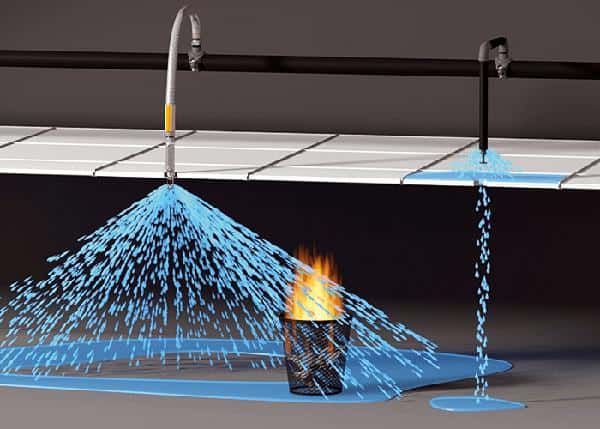
In many cases, fixing a sprinkler’s orientation relies on changing the branch lines, which are the “The pipes supplying sprinklers, either directly or through sprigs, drops, return bends, or arm-overs.”
NFPA defines a “sprig” as “a pipe that rises vertically and supplies a single sprinkler.” NFPA 13 mandates that a sprig that is greater than 4 feet long “shall be restrained against lateral movement” (9.3.6.6). Thus, a broken or missing restraint on a long sprig that winds up moving laterally is one of the ways a sprinkler can get out of alignment.
An arm-over is a “horizontal pipe that extends from the branch line to a single sprinkler or a sprinkler above and below a ceiling,” whereas a return bend is any section of pipe that changes the water’s direction by 180 degrees.
A fire sprinkler drop is any pipe or tube that connects and drops the sprinkler head from the branch line that supplies it with water. To compensate for potential orientation issues – some of which could result from the settling of drop ceilings mentioned above, as well as incidental impact or earthquakes – various manufacturers have created flexible drops that allow sprinklers to be repositioned without having to cut and replace pipe.
In any case, each of these elements must be inspected to make sure that the sprinkler is oriented the right way. If an issue is spotted, it must be fixed. Failure to do so means an intended area is not being covered, which means a fire could gain enough time and fuel to spread.
Missing sprinklers or components
From the 2017 Edition of NFPA 25
5.2.1.1.5 Escutcheons and coverplates for recessed, flush, and concealed sprinklers shall be replaced with their listed escutcheon or coverplate if found missing during the inspection.
5.2.1.1.5.1 Where the listed escutcheon or coverplate from a listed assembly is missing and is no longer commercially available, the sprinkler shall be replaced.
5.2.1.1.6 Escutcheons for pendent sprinklers that are not recessed, flush, or concealed shall not be required to be replaced if found missing during the inspection.
If either escutcheons (the decorative rings that fill the gap around a sprinkler head and the ceiling) or cover plates (which cover concealed sprinkler heads behind an aesthetic plate) are missing, they could impact the intended performance of the sprinkler. Missing escutcheon’s impair “the ability of the ceiling to resist the passage of smoke or heat” and “the sprinkler head (or smoke detector, if so installed) may not operate in a timely manner.” Think of it this way: If smoke has an escape route through the gap around a sprinkler caused by a missing escutcheon, it may accumulate less and delay setting off any detectors.
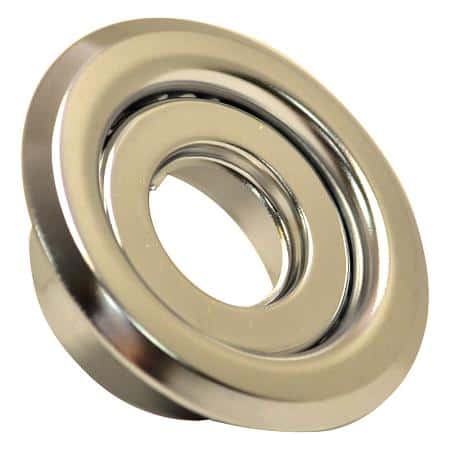
Missing, damaged, or improperly installed cover plates (which usually have an activation temperature about 20 degrees lower than the sprinkler’s, so they drop away first) can have a similar impact on sprinkler activation. The sprinklers can still activate without one present, but the system is designed with the assumption that they are there – and cover plates may be intended to protect sprinkler heads from incidental damage as well as for aesthetic reasons.
Thus, replace both escutcheons and cover plates if they are missing or damaged, except in the case of a missing escutcheon for a pendent sprinkler that is meant to be exposed (not recessed, flush, or concealed). If a replacement part compatible with a specific sprinkler is no longer manufactured, you’ll have to replace the entire sprinkler head with a new version.
You can find a selection of escutcheons and an array of cover plates at QRFS.
Clearance
If piled storage or other obstructions are too close to a sprinkler head, it will not be able to deploy the water in the coverage area intended to fight a fire. You must remedy this:
From the 2017 Edition of NFPA 25
5.2.1.2* The minimum clearance to storage as described in 5.2.1.2.1 through 5.2.1.2.6 shall be maintained below all sprinkler deflectors.
5.2.1.2.1* Unless greater distances are required by 5.2.1.2.2, 5.2.1.2.3, or 5.2.1.2.4, or lesser distances are permitted by 5.2.1.2.6, clearance between the deflector and the top of storage shall be 18 in. (457 mm) or greater.
5.2.1.2.2 Where standards other than NFPA 13 specify greater clearance to storage minimums, they shall be followed.
5.2.1.2.3* Clearance between the deflector and the top of storage shall be 36 in. (914 mm) or greater for special sprinklers.
5.2.1.2.4 Clearance from the top of storage to sprinkler deflectors shall be 36 in. (914 mm) or greater where rubber tires are stored.
5.2.1.2.5 In-rack sprinklers shall not be required to meet the obstruction criteria and clearance from storage requirements.
5.2.1.2.6* Clearance between the deflector and the top of storage shall be permitted to be less than 18 in. (457 mm) where shown to be permitted by the installation standard.
5.2.1.3* Storage closer to the sprinkler deflector than permitted by the clearance rules of the installation standard described in 5.2.1.2.1 through 5.2.1.2.4 shall be corrected.
To break this down: Default to making sure that any shelves, racks, or piled storage – or really any other obstruction – are at least 18 inches away from the sprinkler head’s deflector. Despite NFPA’s language in this section, obstructions aren’t limited to easily moved storage items; they apply to any object that can block a sprinkler, such as “bridging, bracing, lighting, ductwork, cable trays, rainwater leaders, plenums, radiant heaters, high-volume low-speed (HVLS) fans, soffits, ceiling clouds, and other components.”
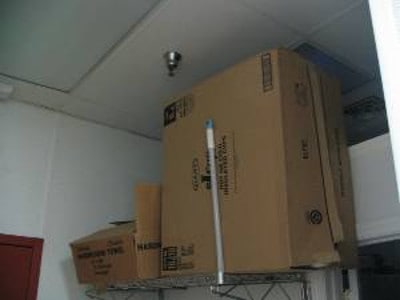
The exceptions to the 18-inch rule are:
- Special sprinklers must be at least 36 inches away from objects. NFPA defines these as sprinklers “intended for the protection of specific hazards or construction features.” They have a specific K-factor, temperature rating, discharge characteristics, and coverage area requirements. (NFPA 13: 8.4.8.1 and 8.4.8.2)
- Stored rubber tires must also be at least 36 inches away from the sprinkler.
- Since in-rack sprinklers are actually embedded in a storage rack to specifically protect items in warehouses, they do not need to meet these clearance requirements.
- If “standards other than NFPA 13 specify greater clearance to storage,” follow them. These standards are essentially the local building and life safety codes adopted by your jurisdiction, so look them up. Chances are that they will match NFPA code, but make certain of it.
Replacement parts
The final aspect of the annual sprinkler head inspection is making sure you have adequate replacement sprinklers plus the tools to install them on hand. Having spares is essential because if a sprinkler head is damaged or completely broken off, it can actually deploy the system or render it entirely ineffective. At a minimum, the inoperable sprinkler will not be able to cover its intended area. The sprinkler head must be replaced immediately.
From the 2017 Edition of NFPA 25
5.2.1.4 The supply of spare sprinklers shall be inspected annually for the following:
(1) The correct number and type of sprinklers as required by 5.4.1.5
(2) A sprinkler wrench for each type of sprinkler as required by 5.4.1.5.5
(3) The list of spare sprinklers as required by 5.4.1.5.6
5.4.1.5* A supply of at least six spare sprinklers shall be maintained on the premises so that any sprinklers that have operated or been damaged in any way can be promptly replaced.
5.4.1.5.1 The sprinklers shall correspond to the types and temperature ratings of the sprinklers in the property.
5.4.1.5.3 Where dry sprinklers of different lengths are installed, spare dry sprinklers shall not be required, provided that a means of returning the system to service is furnished.
5.4.1.5.4 The stock of spare sprinklers shall include all types and ratings installed and shall be as follows:
(1) For protected facilities having under 300 sprinklers — no fewer than 6 sprinklers
(2) For protected facilities having 300 to 1000 sprinklers — no fewer than 12 sprinklers
(3) For protected facilities having over 1000 sprinklers — no fewer than 24 sprinklers
5.4.1.5.5* One sprinkler wrench as specified by the sprinkler manufacturer shall be provided in the cabinet for each type of sprinkler installed to be used for the removal and installation of sprinklers in the system.
The most important aspects of these requirements are that you have the minimum number of replacement sprinklers on hand according to 5.4.1.5.4 and that they match the performance characteristics of the sprinklers they would replace in the system. Ideally, they will be the same model from the same manufacturer. You must also have the right wrench to quickly install them.
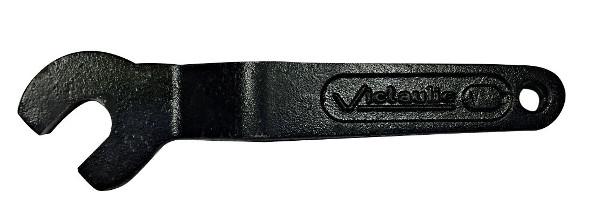
In addition, NFPA requires that you keep a record of these items in the sprinkler cabinet:
From the 2017 Edition of NFPA 25
5.4.1.5.6 A list of the sprinklers installed in the property shall be posted in the sprinkler cabinet.
5.4.1.5.6.1* The list shall include the following:
(1) Sprinkler identification number (SIN) if equipped; or the manufacturer, model, orifice, deflector type, thermal sensitivity, and pressure rating
(2) General description
(3) Quantity of each type to be contained in the cabinet
(4) Issue or revision date of the list
Exceptions to annual visual inspection
NFPA 25 allows exceptions for the annual visual inspection of fire sprinkler heads if the heads are in concealed or hazardous spaces:
From the 2017 Edition of NFPA 25
5.2.1.1.3* Sprinklers installed in concealed spaces such as above suspended ceilings shall not require inspection.
5.2.1.1.4 Sprinklers installed in areas that are inaccessible for safety considerations due to process operations shall be inspected during each scheduled shutdown.
To be continued: What Facility Managers Need to Inspect on a Fire Sprinkler System
This concludes part one of our review of the inspection requirements for commercial fire sprinklers. In the next installment of this series, we discuss the steps needed for an annual visual inspection of pipe and fittings.
If you need to buy parts for your commercial fire sprinkler system, check out QRFS’ selection of commercial fire sprinkler heads, cover plates, escutcheons, and other components and tools, or just use the search bar at the top of the page to find what you’re looking for.
If you have any questions about commercial fire sprinklers or need help finding an item, add a comment below, give us a call at 888.361.6662, or fill out our contact form and we’d be happy to assist.


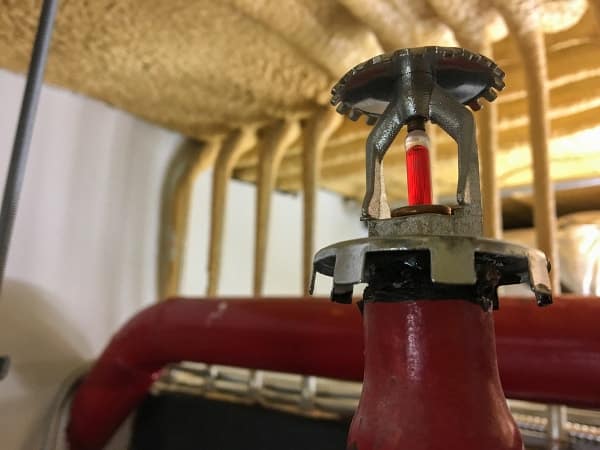
Is there a code for how much gap you can have between the concealer and the ceiling?
Brandon, thanks for commenting! NFPA 13 does detail more information on cover plate installation, but there is no specific code for the distance between the cover plate and the ceiling. It is important that the cover plate isn’t too loose or too tight, however, as either condition may cause the plate and sprinkler to fail to activate on time. To ensure your cover plates are installed correctly, you can work with a licensed fire sprinkler contractor.
very good info, Thanks
very good info, keep up the good work
#sprinklerfitterssaveslife
Looking for clarification on 5.4.1.5.6 A list of sprinklers installed in the property shall be posted in the sprinkler cabinet.
Does this mean a list of the types of sprinklers or a complete list of all sprinklers in the building?
Dave — This is an interesting question—one where NFPA is a little confusing. 5.4.1.5.6 implies a complete list of all sprinklers in the building. But the subsequent reference just specifies the list should include “quantity of each type contained in the cabinet.” And the appendix offers a “minimum”:
A.5.4.1.5.6.1 The minimum information in the list contained in the spare sprinkler cabinet should be marked with the following:
(1) General description of the sprinkler, including upright, pendent, residential, ESFR, and so forth
(2) Quantity of sprinklers to be maintained in the spare sprinkler cabinet
In fact, there is a sample illustration of a list in the appendix that shows this limited info.
Thus, you can get away with just listing what needs to be in the cabinet. That said, you need to know how many total sprinklers are on the property to know how many spares you need to keep on hand, and that info is otherwise useful. So, a list numbering all sprinklers by type may be helpful.
I’m encountering issues where high hazard Storage suppression systems employing ELO k22.4 (metric) upright sprinklers that are using 20mm sprigs (cut and screwed with gal mal sockets) approximately 150mm-200mm long on 6 of 50mm gridded piping to raise the sprinklers to within 300mm of the polystryrene sandwich panelling ceiling.
The majority of the bays are installed using 50mm risers which raise to the 50mm distribution pipework that have sprinklers screw directly into dedicated 20mm sockets as per the final construction drawing. These 6 pipes nominated above are the exception, covering approximately 300m2. The racking in the area is fitted with in-rack sprinklers.
The system is designed based on 12 sprinklers operating.
The system was certified in 2011. It is not clear if the sprigs were installed at the time of certification.
The system was certifier as having been installed in accordance with FMDS 02-00.
As far as I can see, 20mm pipe is smaller piping than the minimum 25mm minimum requirement.
Are the use of 20mm sprigs 200mm long permitted outside of the hydraulic calculation of the system or must they be hydraulically calculated using a minimum pipe size of 25mm or larger?
Is it fair and reasonable to have pointed out this issue in an annual inspection report and request further information?
Angelo — For detailed code and system application questions like this, you can try our Ask a Fire Pro service (at the upper price tier, for this one). Click the link to submit your question with some information about your building or system, and a fire protection professional will provide an answer based on standards and codes. Our pros include AHJs, contractors, engineers, and code experts with 150+ years of combined experience!
Hello
I am a retired Sprinkler Fitter / Contractor that wants to do corrosion control and testing with ultra sound.
I have seen many companies on the web that do this work that are not Journeyman Sprinkler Fitters??
Also, not one company talks about corrosion material build up in 1 inch drops that block sprinklers
and how they remedy that. Considering the millions of heads on drops, this seems to be a large mistake.
A small diameter pipe can be plugged with corrosion faster than larger pipe.
Please tell me what you think should be done.
For system questions like this, you can try our Ask a Fire Pro service. Click the link to submit your question with some information about your building or system, and a fire protection professional will provide an answer based on standards and codes. Our pros include AHJs, contractors, engineers, and code experts with 150+ years of combined experience!
Thanks for the blog. Very useful. What is a commercial sprinkler? Is it possible to have a commercial sprinkler in an industrial facility?
Chris — a commercial sprinkler is really just a term for any non-residential sprinkler. So, commercial sprinklers include sprinklers found in industrial facilities, though those can be specific types of sprinklers designed for those specific environments (like early suppression, fast response sprinklers in warehouses or extra- to ultra-high temperature ratings in hot facilities).
Are the only two ways to clean sprinkler head by air or vacuum or can you use a light rag or brush?
rlittle – Unfortunately, NFPA standards mandate only cleaning sprinklers without touching them. But a Sprinkler Vac attached to a standard vacuum makes it pretty easy to do it.
What does “inspected from the floor level” mean. Let’s say the sprinkler heads are in a skylight area, does it mean that the inspector does not need to climb up a ladder and take a closer look?
Eric — Essentially. Here is an excerpt from a recent NFPA Today piece on the requirements:
“From the floor
A key specification in the standard is that these visual inspections of sprinklers are intended to be conducted from the floor level. This means that typically there should be no special equipment needed for these routine inspections such as ladders or lifts. To further support this concept, NFPA 25 clearly states that sprinklers located in concealed spaces such as above suspended ceilings do not require inspection.”
But they should ABSOLUTELY have a flashlight – non-negotiable. I have written up countless painted sprinkler heads that didn’t look painted until you shined a light on them.
Very good information. Thank you. Regarding clearance from the sprinkler head deflector the common communication is separate storage at least 18 inches from the sprinkler head. The detail about “distance from the deflector” gets routinely lost. With pendent sprinklers it is easy to start the 18 inches from the deflector as they are readily visible. Regarding concealed sprinkler heads obviously the cover is going to melt, expose the deflector and then the deflector drops into position. Is there a good rule of thumb of the deflector dimension? I’ve seen 3/16 – 11/16 ” with some concealed heads. Would say an extra inch be sufficient to capture the majority of deflectors drop dimension from a concealed head? From a communication standpoint this would mean measure 19 inches from the ceiling grid and you have satisfied the 18″ clearance from the deflector. Thanks
Thanks for the thorough explanation on all these topics. I believe I submitted a similar response earlier this week, but have not seen a response. When it comes to clearance and elimination of obstructions from the sprinkler deflector (to ensure optimum performance of the designed spray pattern should the sprinkler activate) in the case of an acoustical ceiling grid, would you consider items installed/hung from the ceiling grid (not a minimum of 18 inches below the deflector) to impede the sprinkler spray pattern? An example would be hanging signage from the ceiling grid. The IFC Chapter 7, 701.2.1 Hanging displays notes the hanging/displaying of items from the ceiling system which is part of the fire-resistant-rated horizontal assembly is prohibited. My understanding of this would be in one respect to eliminate potential spray pattern obstructions. The citation is specific to saleable good and decorative materials, but I would thing other such items such as signage could be assumed as equivalent? Thanks for any thoughts.
Jeff — Thanks for the comment. Unfortunately, the rules for structural and nonstructural obstructions are somewhat complex (for many, pretty confusing) and beyond our practical ability to get into in this format. You might be interested in this related blog on nonstructural obstructions, which includes a scenario. We also offer our Ask a Fire Pro service that can address specific scenarios. Thanks you!
Thank you for the reply and yes the non-structural obstruction blog is a good resource. I just found the QRFS site and appreciate the sharing of information.